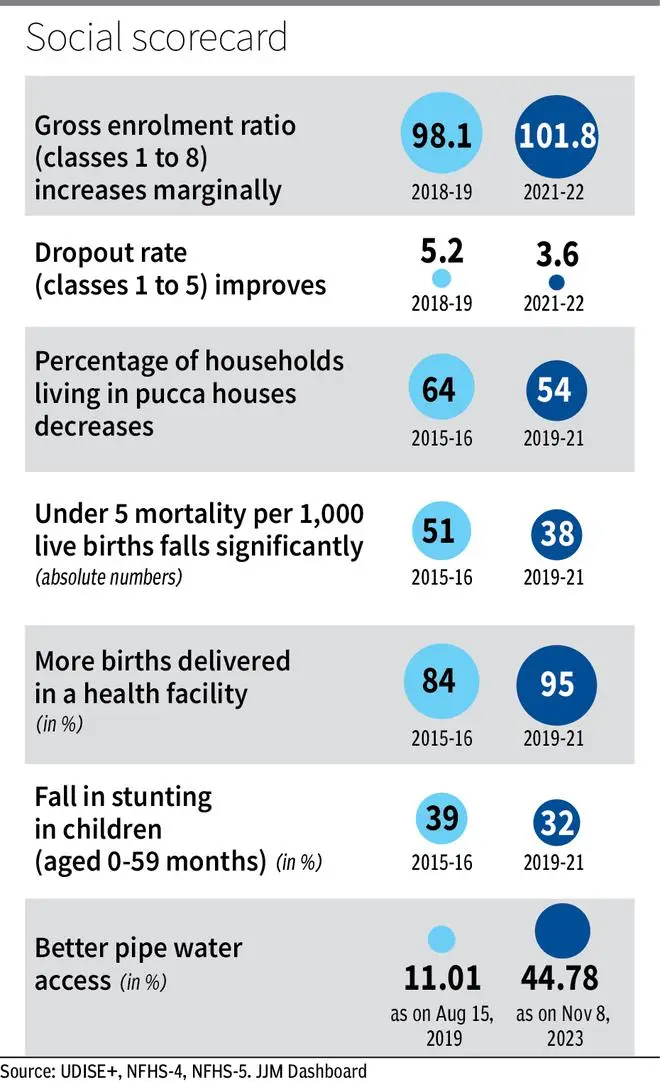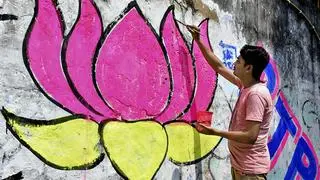Chief Minister Gehlot of Rajasthan has garnered accolades from certain social activists for introducing a ground-breaking Minimum Income Guarantee and Pension scheme. This initiative ensures 125 days of work through the rural or urban employment guarantee and provides a minimum social security pension of ₹1,000 per month. However, this is just one among several social sector schemes implemented by the Rajasthan government, contributing to an increased burden on the State’s finances.
Unsurprisingly, there has been a significant increase in the expenditure on social and economic services by the Rajasthan government over the years. The allocation for social services rose from ₹60,495 crore in 2017-18 to ₹96,119 crore in 2021-22, making it one of the prominent expenditure in the State budget.
Healthy indicators
Due to the implementation of the State’s initiatives, health indicators in the region demonstrate positive trends. The neonatal mortality rate (NNMR) per 1,000 live-births has decreased to 20.2 (NFHS-5, 2020-21) from 29.8 (NFHS-4, 2015-16). Similarly, the infant mortality rate has seen a decline from 41.3 to 30.3 during this period. Institutional births have witnessed a notable increase, rising from 84 per cent to 94.9 per cent. Full immunisation coverage for children aged between 12 and 23 months has risen from 54.8 per cent to 80.4 per cent. Furthermore, the maternal mortality rate (MMR) per lakh live-births has decreased to 113 in 2018-20 from 141 in 2017-19, according to the sample registration system.
The Free Textbook Distribution Scheme by the State government is providing free textbooks to the students studying regularly in classes 1st to 8th in all government schools. The enrolment of students in the government primary schools has gone up from 41.70 lakh in 2018-19 to 46.57 lakh in 2021-22. However, the number of teachers in government primary schools has come down from 1.45 lakh in 2018-19 to 1.44 lakh in 2021-22. The enrolment of students in government upper-primary schools has also gone up from 21.20 lakh in 2018-19 to 25.22 lakh in 2021-22. The enrolment of students has gone up in secondary and senior secondary government schools as well.

Rajasthan, being the largest State of the country in terms of area, has meagre water resources. Interrupted rainfall, depleting water level and a huge livestock has made the task of providing potable water even more challenging. The government data shows that out of 1,21,979 habitations, 53,172 habitations are fully covered; 58,379 habitations are partially covered with availability of safe drinking water.
Around 68.9 per cent of houses in urban Rajasthan are in ‘good’ condition as compared with 68.4 per cent at all-India Level. About 29.3 per cent have been classified under ‘livable’ condition.
How will schemes sustain?
“The increase in school enrolment can be attributed to the provision of free uniforms, books and meals. The right to health has had a positive impact, with more people opting for government hospitals for treatment, reflecting a growing trust in these institutions. The government’s overall performance in social security is commendable, particularly in areas such as women empowerment and reducing child mortality rates, showcasing progress in various social indicators,” said Professor Rashmi Jain at the Department of Sociology, University of Rajasthan.
She added that the reliance on freebies poses a significant financial burden on the government’s treasury. “It is doubtful whether societal progress can be sustained solely through the provision of free benefits. Furthermore, the numbers may not always accurately reflect the ground reality. Despite the opening of numerous colleges, many are understaffed, highlighting challenges in implementation. The government faces the formidable task of sustaining existing schemes and fulfilling new promises amidst the financial strain on the treasury,” she said.








Comments
Comments have to be in English, and in full sentences. They cannot be abusive or personal. Please abide by our community guidelines for posting your comments.
We have migrated to a new commenting platform. If you are already a registered user of TheHindu Businessline and logged in, you may continue to engage with our articles. If you do not have an account please register and login to post comments. Users can access their older comments by logging into their accounts on Vuukle.